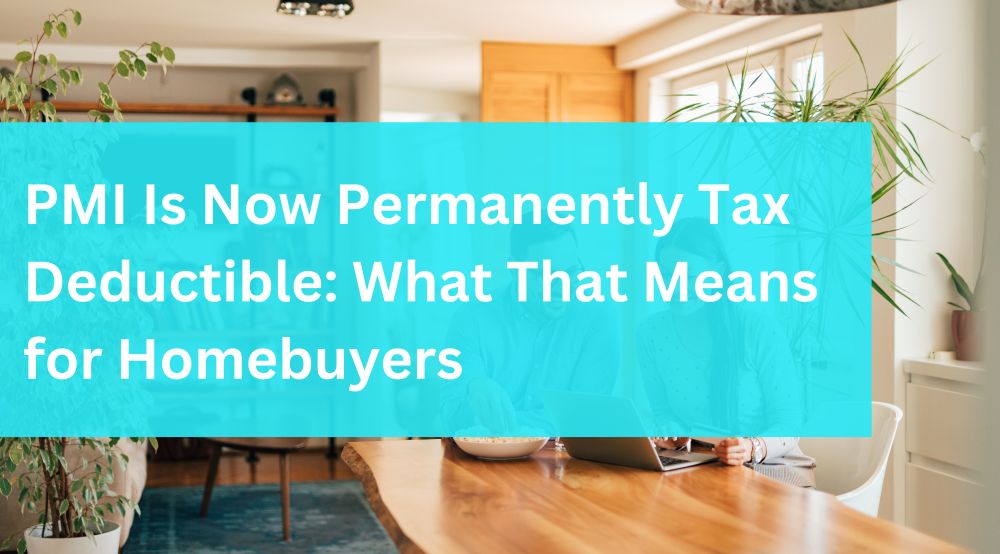For years, Private Mortgage Insurance (PMI) has been a necessary but frustrating cost for many homebuyers, especially first-time buyers putting down less than 20%. The good news? Under recent tax reforms, PMI is now permanently tax deductible.
This change provides meaningful, long-term tax relief for millions of homeowners and makes homeownership more accessible, especially for buyers who need to stretch their dollars.
Let’s break down what PMI is, why this tax change matters, and how it affects your financial strategy if you're considering buying a home or already paying PMI.
🏠 What Is Private Mortgage Insurance (PMI)?
Private Mortgage Insurance (PMI) is typically required by lenders when a borrower puts down less than 20% on a conventional mortgage. PMI protects the lender—not the borrower—if the homeowner defaults on the loan.
PMI costs can vary, but they typically range from 0.3% to 1.5% of the original loan amount annually. For a $500,000 mortgage, that could mean $1,500 to $7,500 per year—added directly to your monthly payment.
While PMI helps borrowers buy homes sooner, it’s long been viewed as a "penalty" for not having a large down payment. The new tax law softens this blow by letting homeowners deduct PMI costs from their federal taxable income—permanently.
🔁 What’s Changing?
Previously, the PMI deduction was subject to periodic extensions and expired several times—creating confusion and uncertainty during tax season. With this reform, PMI is now permanently tax deductible, removing the guesswork.
This means as long as you're paying PMI and itemizing deductions, you can count on reducing your taxable income each year.
💸 Why This Matters for Homeowners
1. It Makes Homeownership More Affordable
By making PMI costs tax-deductible, the government is effectively lowering the net cost of monthly mortgage payments for those with smaller down payments.
Let’s say you’re paying $2,000 per year in PMI. If you’re in the 22% federal tax bracket, you could save $440 annually on your tax bill. That might not sound life-changing on its own, but for budget-conscious buyers, every dollar helps. And this savings continues every year until PMI drops off.
2. It's a Big Win for First-Time and Low-Down-Payment Buyers
Many first-time buyers don't have 20% saved up for a down payment, especially in places with high home prices like San Diego, Los Angeles, or San Francisco. This permanent deduction eases the burden on these buyers and makes the dream of owning a home more achievable.
It’s one more tool in the toolbox for getting into the market without needing to wait years to save up a larger down payment.
3. It Levels the Playing Field
Before, higher-income or cash-heavy buyers had a major advantage when it came to avoiding PMI. With the tax deduction now permanent, buyers using lower down payments can get a little closer to that level—at least from a tax perspective.
🔍 Who Qualifies for the PMI Deduction?
To claim the PMI deduction, you must meet the following criteria:
You have a conventional loan with PMI (FHA mortgage insurance is treated differently)
You’re paying PMI as part of your monthly mortgage payment
You must itemize deductions on your federal tax return
Your adjusted gross income (AGI) must fall within allowable limits (deduction phases out starting around $100,000–$109,000 for single filers or $200,000–$218,000 for joint filers—pending final IRS guidelines)
If you take the standard deduction and don’t itemize, you won’t be able to claim this deduction. However, many homeowners find that when you combine mortgage interest, SALT deductions, and now PMI, itemizing becomes worth it.
📊 Real-World Example
Imagine you're a first-time buyer who just purchased a $600,000 home with 10% down. Your loan amount is $540,000, and your PMI premium is 0.75% of the loan—or $4,050/year.
At a 24% tax bracket, that could equal nearly $1,000 in annual tax savings.
Over the average 5–7 years that PMI is typically paid, that’s $5,000–$7,000 in tax savings—just for using a lower down payment loan.
🧭 Long-Term Impact
By making this deduction permanent, lawmakers have acknowledged the long-term role PMI plays in home financing. It sends a clear message: buyers using conventional loans with less than 20% down are no longer being penalized indefinitely.
This also allows for better long-term financial planning. You can now factor PMI deductions into your expected yearly tax savings without worrying about whether Congress will extend the benefit again.
Final Thoughts: One Less Barrier to Entry
The path to homeownership is already filled with challenges—rising home prices, high interest rates, and competitive markets. This change doesn’t eliminate those obstacles, but it does chip away at one of them.
If you’re already paying PMI or considering buying with less than 20% down, this deduction puts real money back in your pocket—year after year.
Thinking About Buying or Refinancing?
At Beyond Property Management, we help buyers and property owners navigate not just the market, but also the changing tax and financial landscape. Whether you're a first-time homebuyer or an investor, we can connect you with the right resources to make confident, informed decisions.
Want to see how the rest of the tax reform impacts homeowners and landlords?






